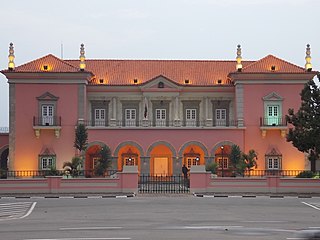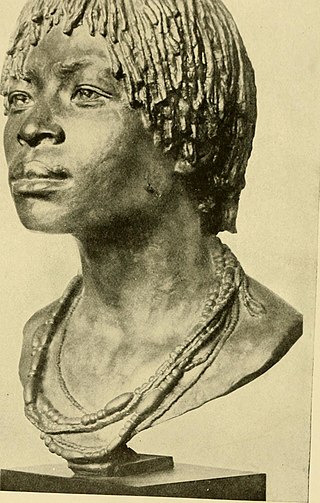Related Research Articles

Nzinga Ana de Sousa Mbande, Nzhinga was a southwest African ruler who ruled as queen of the Ambundu Kingdoms of Ndongo (1624–1663) and Matamba (1631–1663), located in present-day northern Angola. Born into the ruling family of Ndongo, her grandfather Ngola Kilombo Kia Kasenda was the king of Ndongo.

Benguela is a province of Angola, situated in the west of the country. It lies on the Atlantic Ocean, and borders the provinces of Cuanza Sul, Namibe, Huila, and Huambo. The province has an area of 39,826 square kilometres (15,377 sq mi) and its capital is Benguela. According to the 2014 census, there were 2,231,385 inhabitants in the province. The current governor of Benguela is Isaac dos Anjos.

Huambo, formerly Nova Lisboa, is the third-most populous city in Angola, after the capital city Luanda and Lubango, with a population of 595,304 in the city and a population of 713,134 in the municipality of Huambo. The city is the capital of the province of Huambo and is located about 220 km E from Benguela and 600 km SE from Luanda. Huambo is a main hub on the Caminho de Ferro de Benguela (CFB), which runs from the port of Lobito to the Democratic Republic of the Congo's southernmost province, Katanga. Huambo is served by the Albano Machado Airport.

The Kongo people are a Bantu ethnic group primarily defined as the speakers of Kikongo. Subgroups include the Beembe, Bwende, Vili, Sundi, Yombe, Dondo, Lari, and others.
The Kingdom of Ndongo, 1515-1909, was an early-modern African state located in the highlands between the Lukala and Kwanza Rivers, in what is now Angola.

The Ovimbundu, also known as the Southern Mbundu, are a Bantu ethnic group who live on the Bié Plateau of central Angola and in the coastal strip west of these highlands. As the largest ethnic group in Angola, they make up 38 percent of the country's population. Overwhelmingly the Ovimbundu follow Christianity, mainly the Igreja Evangélica Congregacional de Angola (IECA), founded by American missionaries, and the Catholic Church. However, some still retain beliefs and practices from African traditional religions.

The Kingdom of Kongo was a kingdom in Central Africa. It was located in present-day northern Angola, the western portion of the Democratic Republic of the Congo, Southern of Gabon and the Republic of the Congo. At its greatest extent it reached from the Atlantic Ocean in the west to the Kwango River in the east, and from the Congo River in the north to the Kwanza River in the south. The kingdom consisted of several core provinces ruled by the Manikongo, the Portuguese version of the Kongo title Mwene Kongo, meaning "lord or ruler of the Kongo kingdom", but its sphere of influence extended to neighbouring kingdoms, such as Ngoyo, Kakongo, Loango, Ndongo, and Matamba, the latter two located in what is Angola today.

Cuíto, formerly known as Silva Porto, is a city and municipality in central Angola, capital of Bié Province. The municipality had a population of 450,881 in 2014. Projected to be the tenth fastest growing city on the African continent between 2020 and 2025, with a 5.56% growth.

The Ambundu or Mbundu (Mbundu: Ambundu or Akwambundu, singular: Mumbundu are a Bantu people who live on a high plateau in present-day Angola just north of the Kwanza River. The Ambundu speak Kimbundu, and most also speak the official language of the country, Portuguese. They are the second biggest ethnic group in the country and make up 25% of the total population of Angola.

Mvemba a Nzinga, Nzinga Mbemba, Funsu Nzinga Mvemba or Dom Alfonso, also known as King Afonso I, was the sixth ruler of the Kingdom of Kongo from the Lukeni kanda dynasty and ruled in the first half of the 16th century. He reigned over the Kongo Empire from 1509 to late 1542 or 1543.

Pedro II Nkanga a Mvika was a ruler of the kingdom of Kongo during the kingdom's first conflict with the Portuguese. He was the founder of the royal House of Nsundi and could trace his descent to one of Afonso I's daughters. He was succeeded by his son Garcia I, who was crowned in 1624.
The colonial history of Angola is usually considered to run from the appearance of the Portuguese under Diogo Cão in 1482 (Congo) or 1484 until the independence of Angola in November 1975. Settlement did not begin until Novais's establishment of São Paulo de Loanda (Luanda) in 1575, however, and the Portuguese government only formally incorporated Angola as a colony in 1655 or on May 12, 1886.
Bailundo is a municipality, with a population of 294,494 (2014), and a town, with a population of 70,481 (2014), in the province of Huambo, Angola.

The Bailundo revolt was an insurrection launched by the Ovimbundu kingdom of Bailundo and its allies against the Portuguese Empire. The revolt was prompted by the sudden decline of the price of root rubber, pitting the indigenous population against European immigrants and aboriginal loyalists. The revolt lasted between 1902 and 1904, ending in a Portuguese victory.

Mandume ya Ndemufayo was the last king of the Oukwanyama, a subset of the Ovambo people of southern Angola and northern Namibia. Ya Ndemufayo took over the kingdom in 1911 and his reign lasted until 1917 when he died of either suicide or machine gun fire while he was under attack from South African forces. Ya Ndemufayo is honoured as a national hero in both Angola and Namibia.

The Kingdom of Bailundo, also known as Bailundu, Mbailundu or Mbalundu, is an Angolan Ovimbundu kingdom based in the modern-day province of Huambo, in the central highlands of Angola. It was one of the largest and most powerful Ovimbundu kingdoms. Some news reports state the kingdom was founded in the 15th century, however oral histories and archival evidence suggest it emerged as a political entity around 1700. The kingdom was initially called Halavala.
In the 1900s in Angola the colonial economy expanded despite domestic unrest.
The Mbunda or Vambunda are a Bantu people who, during the Bantu migrations, came from the north to south-eastern Angola and finally Barotseland, now part of Zambia. Their core is at present found in the south-east of Angola from the Lunguevungu river in Moxico to the Cuando Cubango Province.

The Ovambo Uprising was an uprising against Portuguese colonial rule in World War I. It lasted from about 18 December 1914 to 6 February 1917 with the death of its leader, King Mandume yaNdemufayo, by South African forces in Namibia. The war pitted Portuguese troops, commanded by General António Júlio da Costa Pereira de Eça, against an Ovambo army, composed mainly of fighters from the Oukwanyama clan.
The Portuguese-Ovimbundu War, also known as the War of 1774-1778, was an armed conflict between the kingdoms of the Ovimbundu people, mainly in the figure of the Bailundo and Viye kingdoms, against the Kingdom of Portugal.
References
- ↑ Thornton, John K. (1999-08-26). Warfare in Atlantic Africa, 1500-1800. doi:10.4324/9780203500446. ISBN 9781135365844. Archived from the original on 2022-08-22. Retrieved 2022-08-22.
- 1 2 Florêncio, Fernando (2017-08-04), "No Reino da Toupeira. Autoridades Tradicionais do M'balundu e o Estado Angolano", Vozes do Universo Rural : Reescrevendo o Estado em África, ebook'IS (in Portuguese), Lisboa: Centro de Estudos Internacionais, pp. 79–175, ISBN 978-989-8862-32-7, archived from the original on 2021-07-28, retrieved 2022-08-25
- ↑ Ball, Jeremy (2000). "A "Time of Clothes": The Angolan Rubber Coom, 1886-1902" (PDF). Ufahamu. 28 (1). doi:10.5070/F7281016584. ISSN 0041-5715. Archived (PDF) from the original on 2022-08-25. Retrieved 2022-08-26– via eScholarship.
- 1 2 3 4 5 6 7 8 9 10 11 12 13 Constança Do Nascimento da Rosa Ferreira De Ceita. Silva Porto na África Central – Viye / Angola: História Social e Transcultural de um Sertanejo (1839-1890) (PDF) (Doctoral thesis). NOVA University Lisbon. hdl:10362/15123. Archived (PDF) from the original on 2022-02-11. Retrieved 2022-08-26.
- 1 2 3 4 5 6 7 8 9 10 Thornton, John K. (2020-03-05). A History of West Central Africa to 1850. Cambridge University Press. doi:10.1017/9781316411568. ISBN 978-1-316-41156-8. S2CID 216423870. Archived from the original on 2022-08-22. Retrieved 2022-08-22.
- 1 2 3 4 5 6 Candido, Mariana P. (2013). An African slaving port and the Atlantic world : Benguela and its Hinterland. Cambridge. ISBN 978-1-107-33648-3. OCLC 830000966. Archived from the original on 2022-08-26. Retrieved 2022-08-26.
{{cite book}}: CS1 maint: location missing publisher (link) - 1 2 Thornton, John K. (1999-08-26). Warfare in Atlantic Africa, 1500-1800. doi:10.4324/9780203500446. ISBN 9781135365844. Archived from the original on 2022-08-22. Retrieved 2022-08-22.
- 1 2 James, W. Martin (2011). Historical dictionary of Angola (2nd ed.). Lanham, Md.: Scarecrow Press. ISBN 978-0-8108-7193-9. OCLC 689858578. Archived from the original on 2022-08-26. Retrieved 2022-08-26.
- ↑ Dulley, Iracema (November 2021). "Chronicles of Bailundo: a fragmentary account in Umbundu of life before and after Portuguese colonial rule". Africa. 91 (5): 713–741. doi: 10.1017/S0001972021000553 . ISSN 0001-9720. S2CID 244530267.
- 1 2 Okuma, Thomas Masaji (1964). The Social Response of Christianity in Angola: Selected Issues (PDF) (PhD dissertation). Boston University. Archived (PDF) from the original on 2022-08-26. Retrieved 2022-08-26.
- ↑ "HPIP". Archived from the original on 2022-08-26. Retrieved 2022-08-26.
- ↑ Melnysyn, Shana (November 2019). "Mbailundu Remembered: Colonial Traces in Post-Civil War Angola". Kronos. 45 (1): 140–153. doi: 10.17159/2309-9585/2019/v45a10 . ISSN 0259-0190. S2CID 216673589.
- ↑ McCulloch, Merran (2017). The Ovimbundu of Angola. London. ISBN 978-1-315-30502-8. OCLC 971613394.
{{cite book}}: CS1 maint: location missing publisher (link)